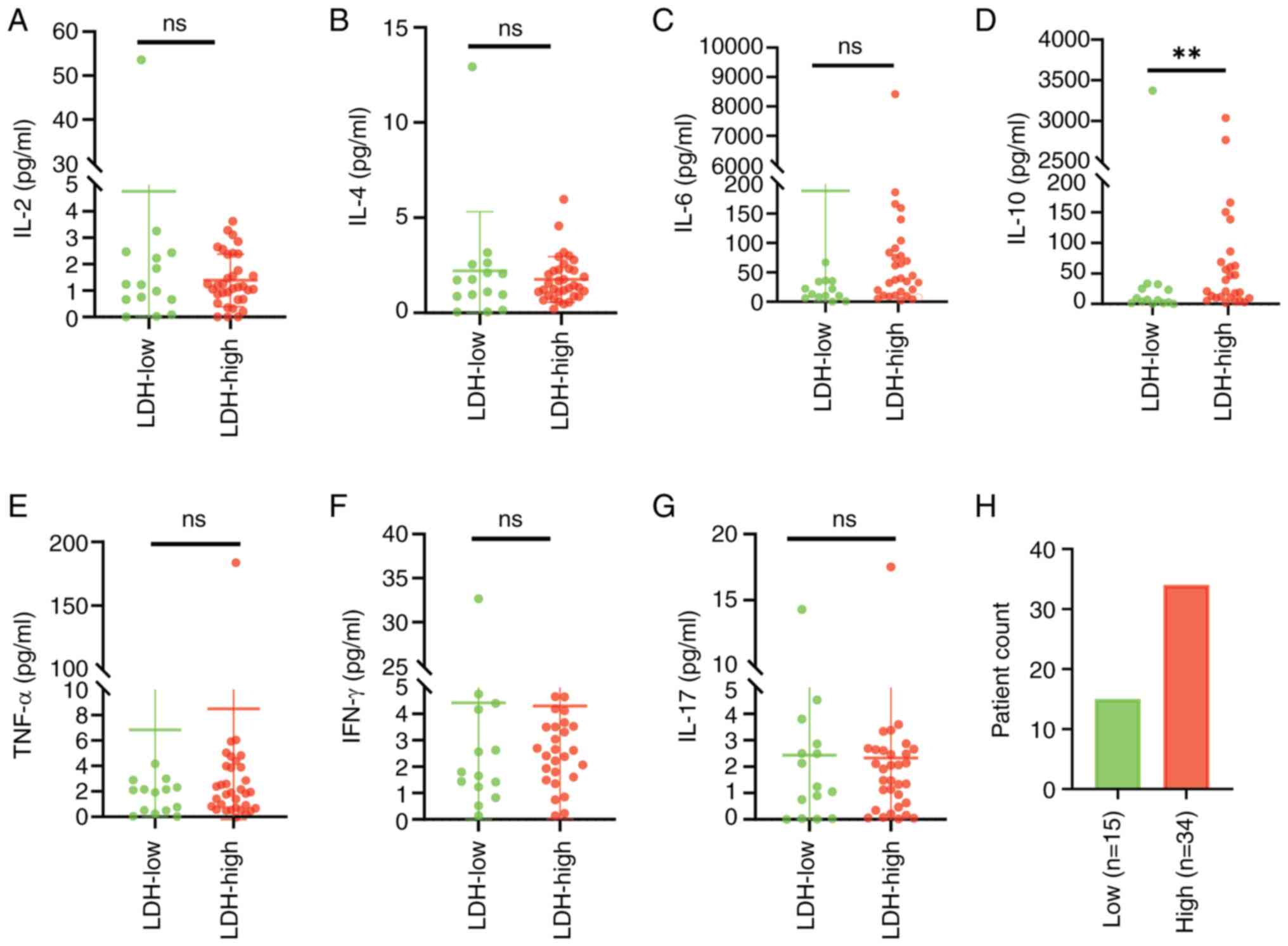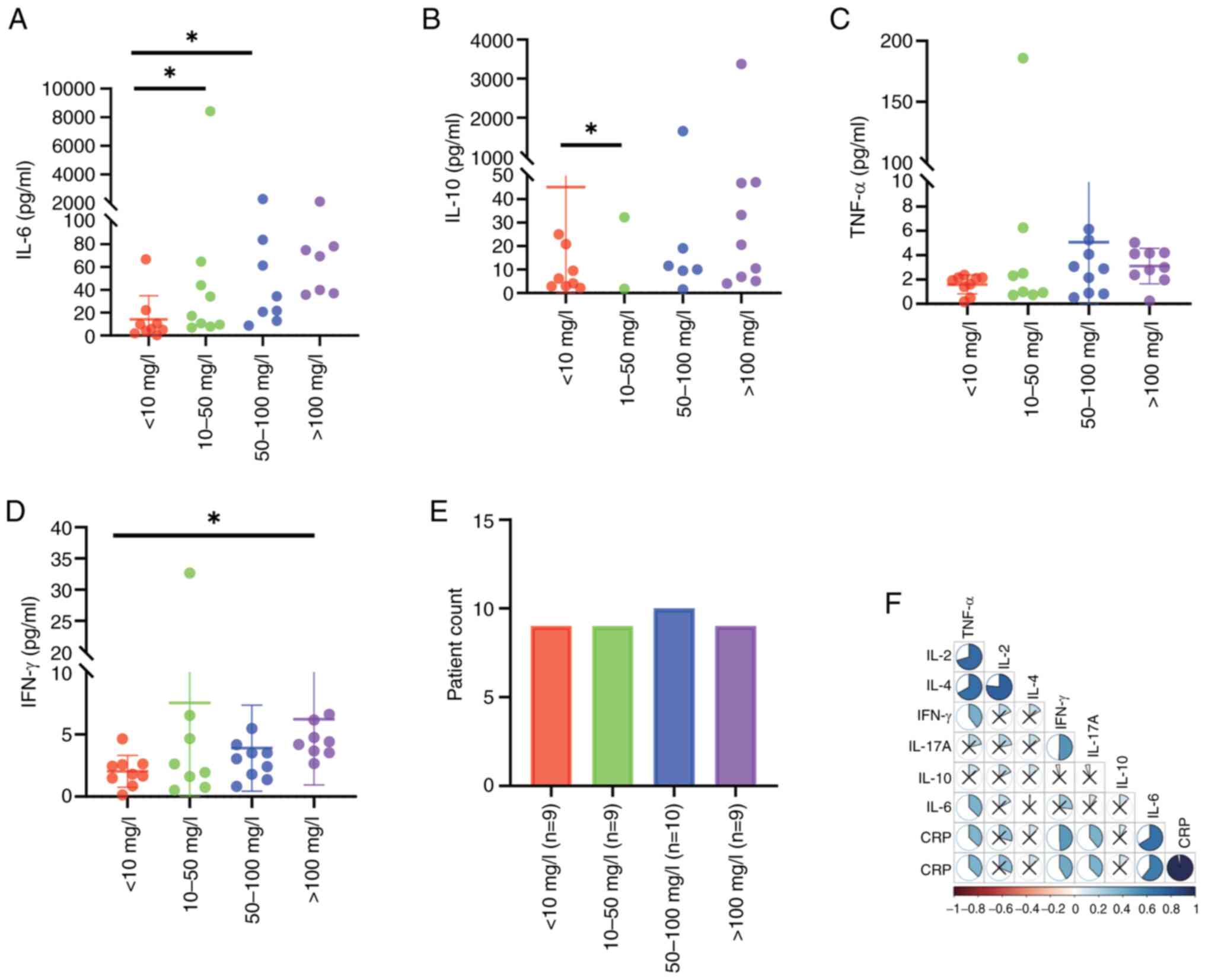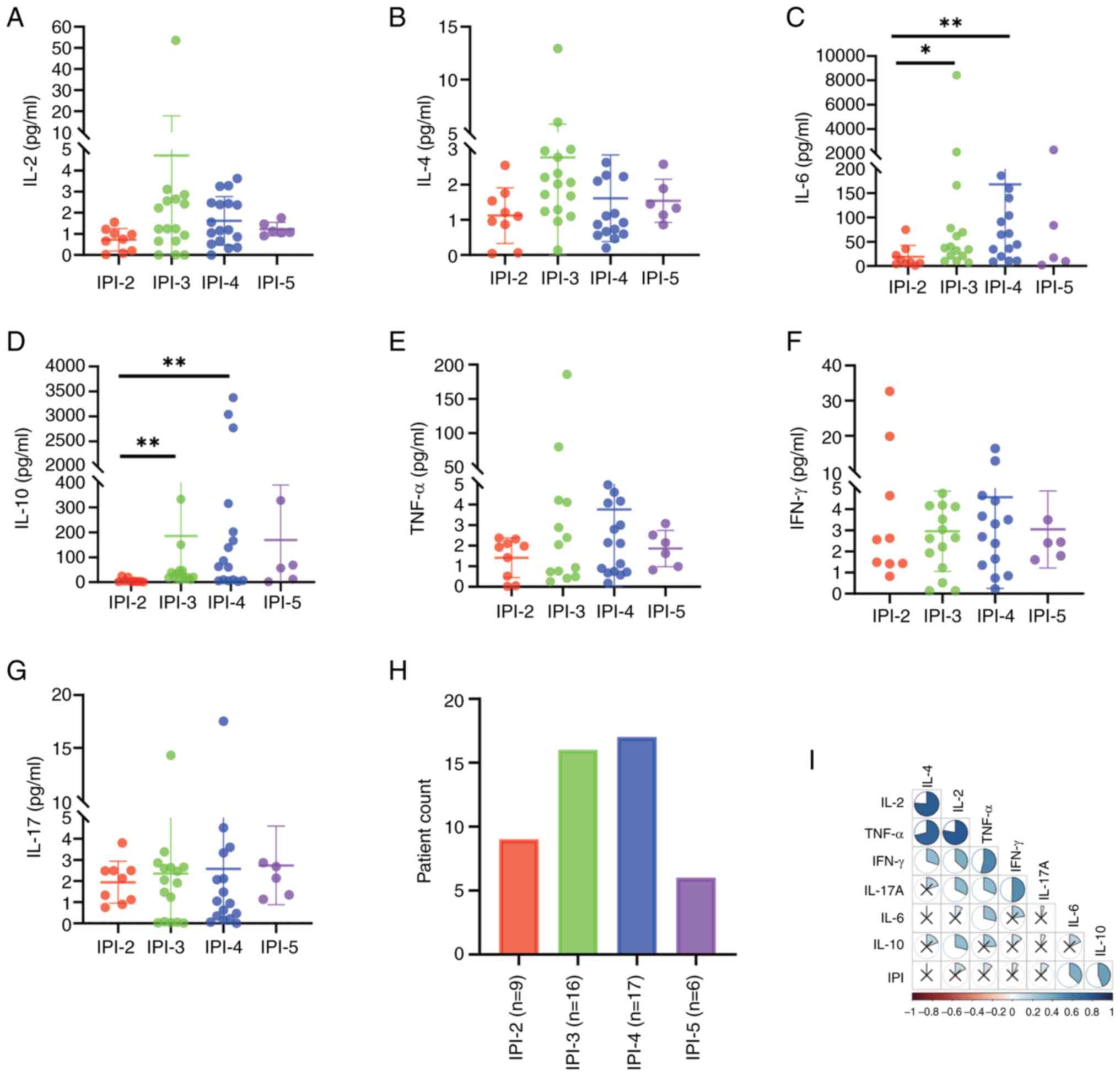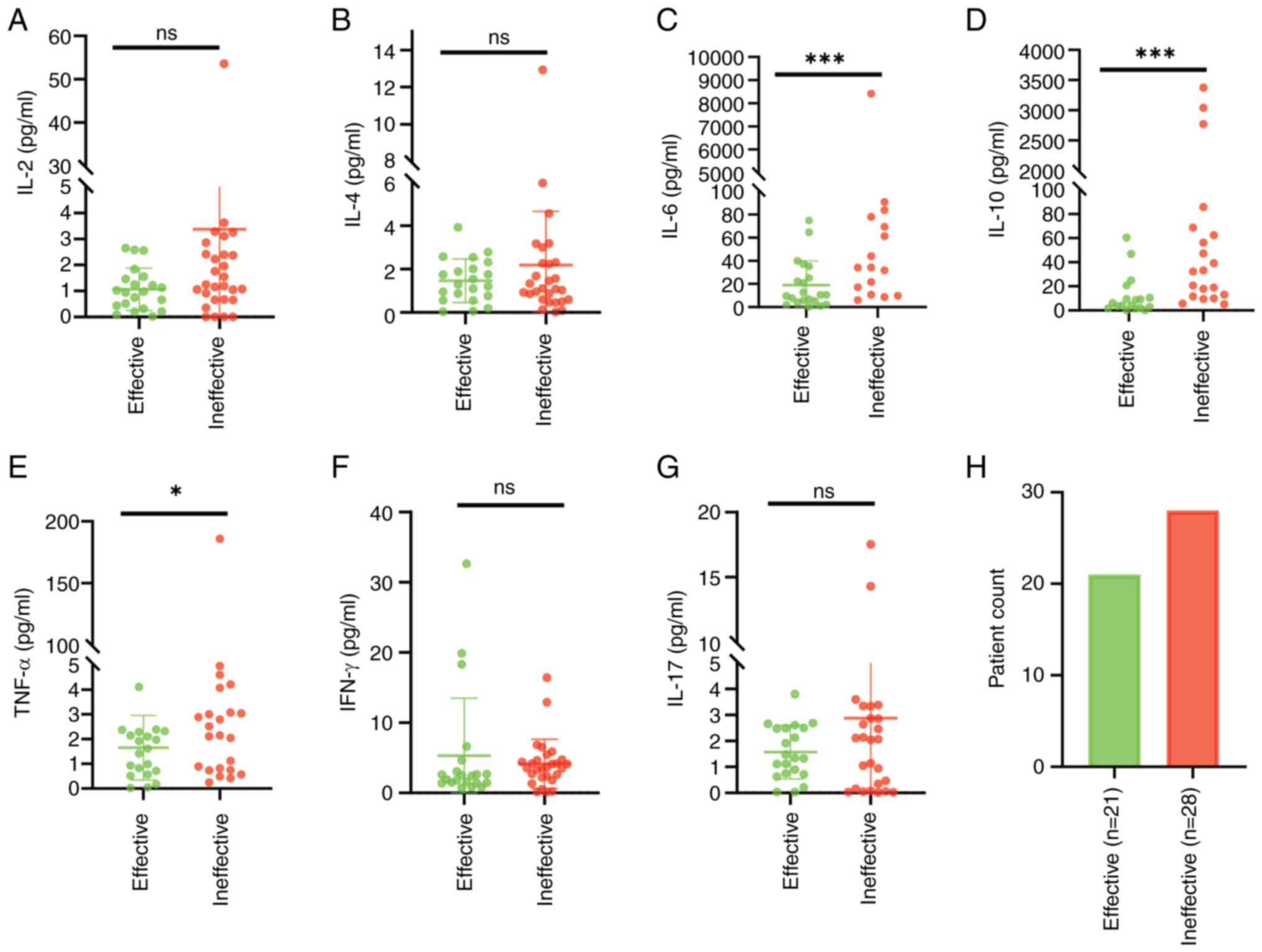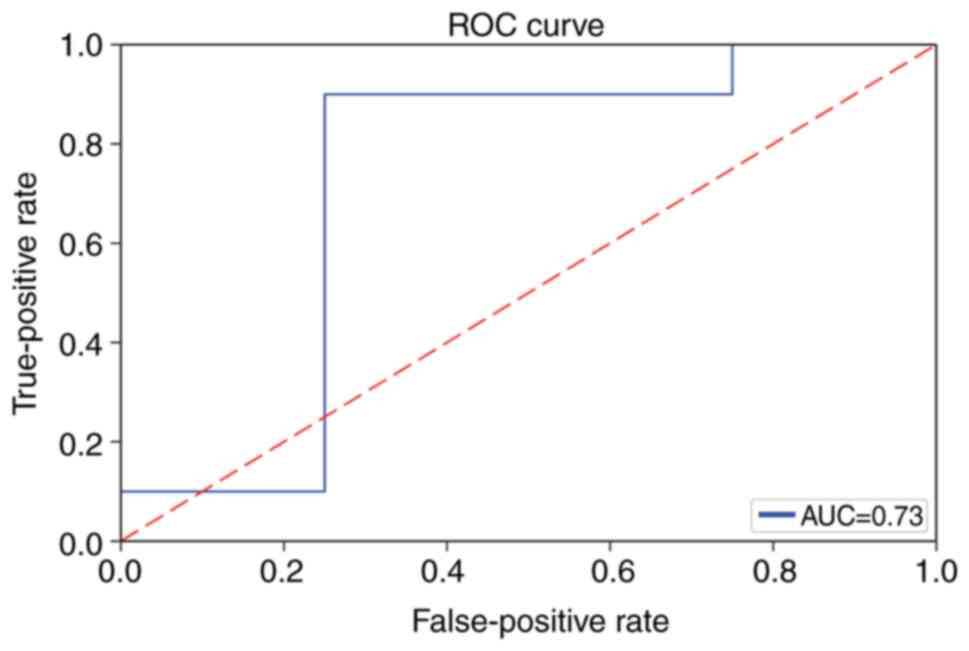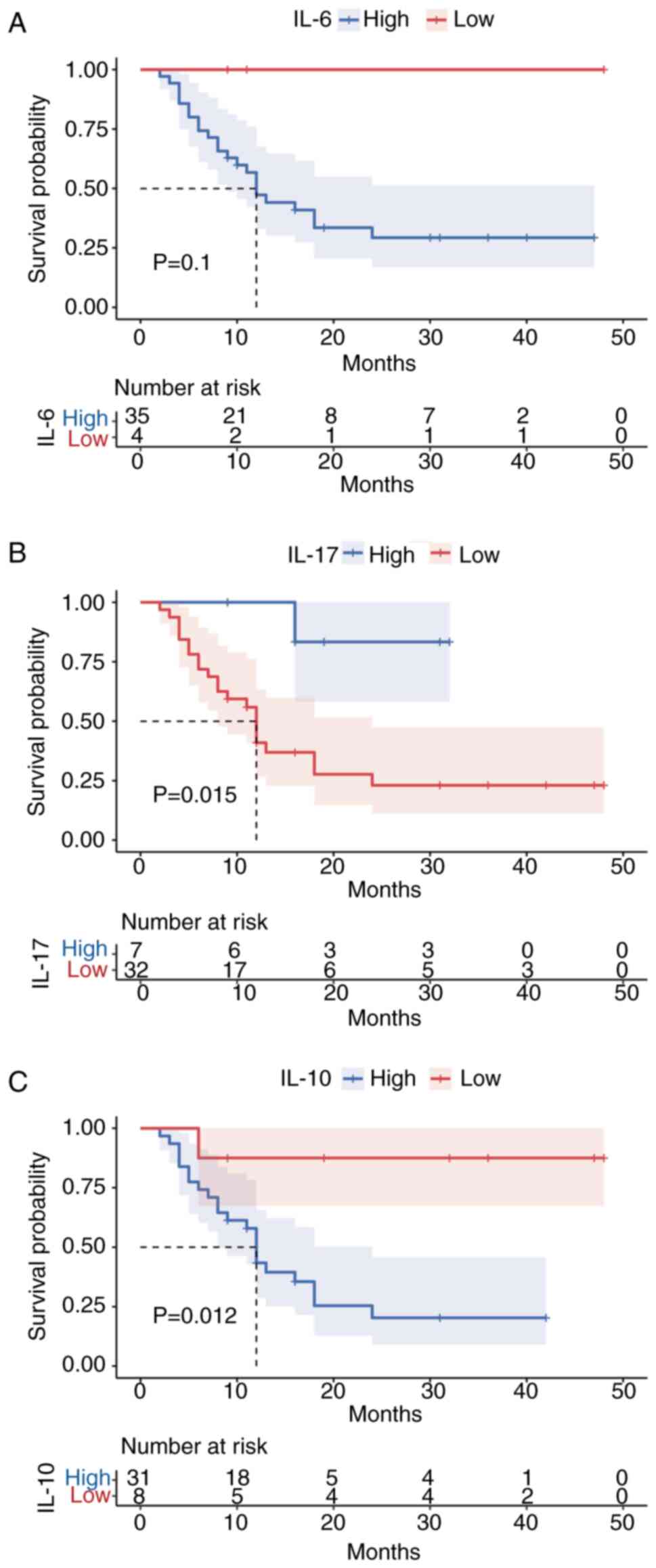Assessment and prognostic significance of a serum cytokine panel in diffuse large B‑cell lymphoma
- Authors:
- Published online on: March 28, 2024 https://doi.org/10.3892/ol.2024.14370
- Article Number: 237
-
Copyright: © Xie et al. This is an open access article distributed under the terms of Creative Commons Attribution License.
Abstract
Introduction
DLBCL is a mature B-cell malignancy that is frequently found among adults with non-Hodgkin's lymphoma (NHL) (1). In China, DLBCL accounts for 40.1% of all NHL cases, and it has attracted increasing attention due to its high morbidity and mortality rates. At present, the pathogenesis of DLBCL is unclear, although several studies have indicated a close association with inflammation-triggered immune dysfunction, a condition mediated by cytokines (2,3). The rituximab, cyclophosphamide, Adriamycin, vincristine and prednisone (R-CHOP) regimen is the current first-line treatment for DLBCL, and it produces satisfactory remission rates in most patients. However, 30–40% of patients either fail to respond to R-CHOP or relapse within the first months of treatment (4,5). These differences in response and prognosis indicate the importance of establishing an accurate method for patient stratification. The role of immune escape in disease development is not adequately reflected by the International Prognostic Index (IPI) score, which is now the gold standard for the prognostic assessment of patients with DLBCL. Moreover, the accuracy of the IPI tends to be low for the standard treatment, even when the treatment includes rituximab (6). Thus, it is essential to identify novel biomarkers to improve the accuracy of the IPI scoring system. It has been found that the levels of certain cytokines are strongly correlated with the onset, severity and prognosis of DLBCL (7–9), although there is limited information on this topic in patients with DLBCL in China. Thus, in view of the differences observed between domestic and foreign environments, patient pathogenic factors and high DLBCL heterogeneity, the present study examined the cytokine profiles of Chinese patients with DLBCL using flow cytometry. These findings will provide new ideas for the prognostic analysis and clinical treatment of DLBCL worldwide.
Materials and methods
General information
The study enrolled 60 patients with pathologically confirmed B-cell NHL (B-NHL) (38 men and 22 women; age range, 36–91 years; median age, 65 years) who were treated at Zhejiang Provincial People's Hospital (Hangzhou, China) between January 2017 and January 2020. The diagnostic criteria were in accordance with the reported literature (10). Among the selected participants were 11 with chronic lymphocytic leukemia/small lymphocytic lymphoma (CLL/SLL), 49 with primary DLBCL and 21 patients with DLBCL in remission after treatment. Patients with dry syndrome or other diseases involving the immune system that affect cytokine levels, severe infections, a second malignant haematological disease, severe target organ damage with a survival rate of <1 year, other neoplasms, diabetes or other metabolic diseases were excluded. The control cohort consisted of 67 healthy volunteers. The four groups were comparable in terms of sex and age. The final follow-up was conducted in January 2021, the minimum follow-up period was 12 months and the follow-up was terminated at the death of the patient. Written informed consent was obtained from all patients for participation in this study.
Sub-cohort of patients with DLBCL
General clinical information was collected for all patients. This included LDH and CRP levels, bone marrow aspiration and biopsy results, and ultrasonography and imaging results, such as radiographs, computed tomography (CT) or positron emission tomography-CT scans. During the analysis, CRP was found to be a more sensitive indicator, and the correlation between the elevation of this indicator and other cytokines showed a phase correlation, so it was divided into four groups with different degrees of elevation: Group 0, 0–10 mg/l CRP; group 1, 10–50 mg/l CRP; group 2, 50–100 mg/l CRP; and group 3, >100 mg/l CRP. Patients also received an IPI score based on five factors, including age, behavioral status, Ann Arbor stage (11), LDH expression level and number of invaded sites of extranodal lesions. The IPI score can be used to classify patients into four different risk groups: A score of 0/1 for low risk; 2 for low to medium risk; 3 for medium to high risk; and 4/5 for high risk.
The 49 patients with DLBCL were treated with the R-CHOP regimen over a 21-day treatment period. The R-CHOP chemotherapy regimen is as follows: i) Rituximab, the dosage of which is usually determined according to 365 mg/m2 body surface area, and is administered intravenously on day 1, during which time the patient should be observed for possible side effects such as allergic reactions, and it is best to monitor the patient using automatic ECG monitoring. ii) Cyclophosphamide, the dosage of which is calculated according to 750 mg/m2 body surface area, and is administered intravenously on day 2. iii) Vincristine, the dosage of which is calculated according to 1.4 mg/m2 body surface area, and is administered intravenously on day 2. iv) Adriamycin, the dosage of which is calculated according to 50 mg/m2 body surface area, and is also administered intravenously on day 2. v) Prednisone, which is usually administered orally at 100 mg once a day, from day 2 to day 6, for a chemotherapy cycle of 21 days, where the dose is given for the first 6 days, and the time after that is the inter-chemotherapy period, when side effects are observed and managed. The above body surface area is generally calculated according to a formula based on the patient's height and weight. All patients received three courses, after which an efficacy evaluation was conducted according to the NCCN Clinical Practice Guidelines in Oncology for B-Cell Lymphomas (12). Patients with complete and partial remission were included in the cohort of effectively treated patients (n=21), while those showing disease progression and no remission formed the ineffectively treated cohort (n=28).
Overall, long-term follow-up data were available for 39 patients with DLBCL, while the remaining patients were lost to follow-up. In addition, 16 patients died during the first year after treatment, while 23 patients survived for 1 year or more. These patients were included in the deceased and survived cohorts, respectively (Fig. S1). For survival curves, the reference ranges of cytokines were consistent with those reported by the Department of Pathology of Zhejiang Provincial People's Hospital. The IL-6 cut-off value was 5.00 pg/ml, the IL-10 cut-off value was 5.00 pg/ml and the IL-17 cut-off value was 3.00 pg/ml.
Cytokine assays
Cytokine levels were measured in the sera of all participants before treatment using a Beckman Navios flow cytometer (cat. no. B47905; Beckman Coulter, Inc.) and a Th1/Th2/Th17 Cytometric Bead Array cytokine kit (cat. no. 560484; BD Biosciences), according to the manufacturer's protocols. Fasting venous blood (5 ml) was collected from the arm of all subjects. The blood samples were allowed to stand for 2 h at room temperature and then centrifuged at 1,000 × g for 5 min at 4°C. The sera were stored at 4°C. The measurement of IL-2, IL-4, IL-6, IL-10, IL-17, TNF-α and IFN-γ levels was completed within 24 h. The software used for data analysis was FCAP Array™ version 3.0.1 from BD Biosciences.
Statistical analysis
All data were analyzed using SPSS 20.0 (IBM Corp.). Cytokine levels between two groups were compared utilizing the Mann-Whitney U test. Differences in cytokine levels among multiple groups were assessed through the Kruskal-Wallis test. The post hoc analysis used was the Bonferroni test. Two-tailed Spearman correlations were used to assess associations between cytokine levels and CRP levels and IPI scores. P<0.05 were considered to indicate a statistically significant difference.
Generation of the prediction model
The support vector machine (SVM) algorithm was used to construct a model for prognosis prediction for patients with DLBCL (13). This was generated using the results of the cytokine analysis, as determined by flow cytometry. The data on cytokine levels were then separated into two categories, namely, 80% for training and 20% for validation. Using the e1071 package with the random number set to 123, optimization of the penalty coefficient C was conducted via tune.svm (14). The optimization range was between 0.005–1, the optimization step was 0.005, and γ was set to 1. The optimal SVM model was derived with a C-classification, radial SVM kernel and an optimal C of 0.895.
Results
Expression profiles of seven cytokines in patients with primary DLBCL and primary CLL/SLL, and normal control volunteers
The IL-6 (P<0.001) and IL-10 (P<0.01) levels were significantly raised in patients with primary DLBCL compared with those in the controls (Table I). Meanwhile, although the TNF-α, IFN-γ and IL-17 levels were increased slightly in primary DLBCL patients, they did not reach significance. No changes were seen in the levels of IL-2 and IL-4 between the two cohorts (P>0.05; Table I; Fig. S2) nor were there significant differences in cytokine levels between patients with primary CLL/SLL and healthy controls (P>0.05; Table I), suggesting that altered serum cytokine levels are specific to the early diagnosis of DLBCL. Representative flow cytometry plots of two patients are presented in Fig. S3A, where it can be seen that both patients had relatively elevated IL-6 and IL-10 in their test results.
Table I.Expression of seven cytokines in the primary DLBCL, primary CLL/SLL and healthy control groups. |
Cytokine expression in patients with DLBCL in sustained remission after treatment
Apart from a rise in the serum IL-6 levels (P<0.05), no significant differences were observed between serum cytokine levels in the 21 patients with DLBCL who achieved sustained remission following standard treatment and healthy controls during the same period (P>0.05; Table II). This suggested a close association between cytokine production and disease progression in patients with DLBCL.
Association between serum cytokine levels and clinicopathological features in patients with DLBCL at first presentation
Elevated LDH expression at the first presentation was found to be closely associated with prevalence. Patients with increased levels of serum LDH had considerably higher IL-10 values than those with normal LDH (Z=2.368 and Z=3.143; P=0.018 and P=0.002, respectively), although the levels of the remaining cytokines showed no significant differences (P>0.05; Fig. 1). It was also observed that raised CRP was associated with markedly higher IL-6 and IL-10 levels, compared with patients with normal CRP, with significance shown for 10–50 and 50–100 mg/l for IL-6, and for 10–50 mg/l for IL-10 (P<0.05; Fig. 2A-E). Moreover, the degree of increase in IL-6 was positively correlated with the serum CRP (P<0.001, r=0.662; Fig. 2F). By contrast, the levels of IFN-γ only increased in patients with CRP >100 mg/l, respectively (P<0.05; Table SI). There were 12 patients with missing CRP data; therefore, CRP data for 37 patients are counted here.
Associations between serum cytokine profiles and IPI scores in patients with DLBCL at first presentation
Fig. 3A-G shows the distribution of IPI scores in the 48 patients with DLBCL; 1 patient had an IPI score of 1 and its data were therefore not included. There were significant differences in serum IL-6 and IL-10 levels between sub-cohorts of patients with different IPI scores compared with those with an IPI score of 2 (IL-6: H=11.214, P=0.011; IL-10: H=15.203, P=0.002). Levels of both IL-6 and IL-10 were increased in patients with IPI scores of 4 (P<0.05; Table SII), and there was a positive correlation between the IPI score and serum IL-6 and IL-10 levels (IL-6: P=0.007, r=0.380; IL-10: P=0.002, r=0.438; Fig. 3I). Moreover, although differences in TNF-α between the two cohorts did not reach statistical significance (H=3,474, P=0.324), levels were higher in patients with IPI scores of ≥3, relative to those with IPI scores of 2 (Fig. 3E).
Predictive model of short-term treatment response in patients with DLBCL using the SVM analysis of cytokines
The 49 patients with primary DLBCL included 21 that responded to treatment and were effectively treated, and 28 that did not and were ineffectively treated. Analysis showed that compared with the effectively treated patients, those that were ineffectively treated had significantly higher levels of IL-6 and IL-10 (both P<0.01), as well as TNF-α (P<0.05) (Table III). However, IFN-γ did not differ significantly between the two groups, despite an observed increase in ineffectively treated patients (Fig. 4).
Table III.Serum cytokines in patients with diffuse large B-cell lymphoma in the effective and ineffective groups of short-term treatment. |
The data on cytokine levels were then separated into two categories, namely, 80% for training and 20% for validation. Using the e1071 package with the random number set to 123, optimization of the penalty coefficient C was conducted via tune.svm. The optimization range was between 0.005–1, the optimization step was 0.005, and gamma was set to 1. The optimal SVM model was derived with a C-classification, radial SVM kernel and an optimal C of 0.895. Using this optimal SVM model, the prediction test group accuracy was 78.57% (Fig. S3B), and the area under the ROC curve was 0.73 (Fig. 5).
Association between overall survival and serum cytokine levels in patients with DLBCL
Of the 39 patients with DLBCL who had long-term follow-up data, 16 died (deceased cohort) and 23 survived (survived cohort) during the 12 months of follow-up. The deceased patients showed higher serum IL-6 and IL-10 levels, while the patients who survived had higher IL-17 levels (P<0.05); no significant changes were seen in the remaining cytokines (P>0.05) (Table IV). Notably, based on the survival plots, only IL-6 was not significantly associated with survival prognosis in patients with DLBCL (P>0.05) (Fig. 6).
Table IV.Differences in serum cytokines between patients with diffuse large B-cell lymphoma in the clinical deceased and survival groups. |
Discussion
As a particularly aggressive form of NHL, DLBCL has higher morbidity and mortality rates than other NHL subtypes (15). Thus, it is imperative to identify novel indicators that can assist in the early diagnosis and prognostic assessment of DLBCL patients. Recently, the measurement of cytokine levels and the expression of their associated receptors has become an essential component of basic and clinical immunology research, as serum cytokine levels have been shown to be important in the early diagnosis of disease and the prediction of prognosis, and even in assessing the efficacies of antitumor drugs and formulating individualized treatment plans (16). In the present study, the serum levels of cytokines were measured in patients with DLBCL using flow cytometry to provide novel ideas for the early diagnosis, clinical treatment and prognostic analysis of DLBCL.
In recent decades, in the process of exploring new methods for the diagnosis and treatment of B-NHL, particularly DLBCL, the number of studies on IL-6, IL-10, TNF-α and IFN-γ has gradually increased. IL-6 is a potent cytokine that promotes the growth and differentiation of B lymphocytes, and is an essential component of the lymphoma microenvironment; it also induces angiogenesis in tumors, disrupts adhesion between tumor cells, and strongly counteracts antitumor actions in the body, thereby promoting the growth and proliferation of tumor cells, while inhibiting apoptosis, initiating a vicious cycle (17,18). Although IL-10 is known to possess antitumor effects mediated by CD8+ T-cell responses, in the presence of CD19+ tumor cells, IL-10 can potentially serve as a growth factor for tumorigenic B lymphocytes, and promote the immune escape of tumor cells (19,20). IL-10 also inhibits apoptosis through the upregulation of Bcl-2 expression, thus promoting tumorigenesis (21). TNF-α is one of the first cytokines released during inflammation, and it is critical for the initiation of the cytokine cascade. Elevated expression of TNF-α and its associated receptors [soluble TNF-receptor 1 (sTNF-R1) and sTNF-R2] has been linked with reduced overall survival in numerous tumors, including breast and stomach cancer (22–25). However, the role of TNF-α in DLBCL remains unclear. IFN-γ has classical antitumor effects, but these may change in the tumor microenvironment. Some studies have demonstrated that IFN-γ significantly enhances oncogenic activity via B invasive lymphoma protein 1/ADP ribose convertase 9 in patients with high-risk DLBCL (26). The role of IL-17, a characteristic Th17 cell-secreted cytokine in tumors, remains controversial. It was previously found that in B-NHL, increased levels of transforming growth factor β inhibited Th17 cell differentiation while promoting the differentiation of regulatory T cells, reducing the antitumor activity and thus enabling tumor immune escape (27).
The levels of IL-6, IL-10 and IFN-γ were significantly higher in patients with DLBCL compared with those in healthy controls in the present study. Significantly increased levels of TNF-α were also observed, confirming the association between aberrant cytokine expression and DLBCL occurrence. No significant differences were observed in these cytokines when comparing between the patients with CLL/SLL and the healthy controls. Although some prior studies reported that serum IL-6 and IL-10 levels remained high in patients with CLL/SLL, these results were primarily associated with certain high-grade patients (28). The present study found that serum cytokine levels have limited diagnostic significance for the inert B-cell lymphoma represented by CLL, while showing specificity for DLBCL. Additionally, in patients with DLBCL, the levels of most cytokines such as OL-10 and IL-17, with the exception of IL-6, often returned to normal on remission of the disease. This suggested that cytokines are significantly associated with disease progression, suggesting a potential treatment strategy for patients with DLBCL. Furthermore, elevated LDH and CRP were associated with prevalence rate in patients with DLBCL, and it was found that patients with increased serum CRP or LDH levels also had higher levels of IL-6 and IL-10, and that the increased production of these factors was positively associated with serum CRP. This was consistent with the report by Nacinovic-Duletic et al (29). Furthermore, there was a strong correlation between the IPI risk stratification and circulating IL-6 and IL-10 levels in the patients with DLBCL. IL-10 was significantly higher in patients with low-risk IPI scores, relative to those with high-risk scores, and the difference was greater with higher scores. This is in agreement with the findings reported by Aydin et al (30); however, the assay used in the present study is simpler and more efficient than the ELISA method that was used by this study. In terms of treatment efficacy, it was found that elevated IL-6, IL-10 and TNF-α levels were often predictive of poor treatment effectiveness, consistent with the findings reported by Dlouhy et al (7). In addition, several studies have reported the roles of single cytokines or combinations of a few cytokines in NHL (31–35) while the present study included a more complete range of cytokines and a more detailed analysis of the various correlations with the disease. The present study further tested cytokines using the SVM algorithm, and the accuracy of the optimal SVM model for the prediction of short-term treatment efficacies in patients with DLBCL was 81.63%. These findings suggest that cytokines are important indicators of the DLBCL treatment response.
Analysis of long-term follow-up data showed that, in comparison with DLBCL patients who survived, those who died within 1 year of treatment had elevated levels of IL-6, IL-10 and IL-17. However, analysis of the survival curves showed that IL-6 levels did not correlate with overall survival in patients with DLBCL. This suggests that there are some limits to the use of serum cytokine levels for predicting the long-term prognosis of patients with DLBCL.
In conclusion, serum IL-6, IL-10, IL-17, TNF-α and IFN-γ levels can serve as prognostic indicators for the assessment of tumor immune status in DLBCL. Moreover, in combination with the IPI score, they can be important indicators of DLBCL prognosis, and may also provide a basis for the precise treatment and direction of novel and efficacious targeted therapies.
Supplementary Material
Supporting Data
Supporting Data
Acknowledgements
Not applicable.
Funding
This study was supported by the Foundation of Science Technology Department of Zhejiang Province (grant no. LGF22H080012) and the Zhejiang Provincial Medical Technology Plan Project (grant nos. 2022KY505 and 2020KY052).
Availability of data and materials
The data generated in the present study may be requested from the corresponding author.
Authors' contributions
SX, LZ and LW collected and analyzed the data, drew figures and tables, and contributed in writing the manuscript. SW, LZ and SX performed the statistical analysis. XT procured the funding for this study. XT, WN, SW participated in the design of the study, gave administrative or logistical support for this study, and reviewed drafts of the paper. All the authors agreed with the conclusions of this study. All authors have read and approved the final manuscript. SX and WN confirm the authenticity of all the raw data.
Ethics approval and consent to participate
This study was approved by the Ethics Committee of the Zhejiang Provincial People's Hospital (approval no. 2021QT150). Written informed consent was obtained from all patients for participation in this study.
Patient consent for publication
Not applicable.
Competing interests
The authors declare that they have no competing interests.
References
|
Tout M, Casasnovas O, Meignan M, Lamy T, Morschhauser F, Salles G, Gyan E, Haioun C, Mercier M, Feugier P, et al: Rituximab exposure is influenced by baseline metabolic tumor volume and predicts outcome of DLBCL patients: A lymphoma study association report. Blood. 129:2616–2623. 2017. View Article : Google Scholar : PubMed/NCBI | |
|
Tárnok A, Hambsch J, Chen R and Varro R: Cytometric bead array to measure six cytokines in twenty-five microliters of serum. Clin Chem. 49:1000–1002. 2003. View Article : Google Scholar : PubMed/NCBI | |
|
Malaponte G, Hafsi S, Polesel J, Castellano G, Spessotto P, Guarneri C, Canevari S, Signorelli SS, McCubrey JA and Libra M: Tumor microenvironment in diffuse large B-cell lymphoma: Matrixmetalloproteinases activation is mediated by osteopontin overexpression. Biochim Biophys Acta. 1863:483–489. 2016. View Article : Google Scholar : PubMed/NCBI | |
|
Lim SH, Woo SY, Kim S, Ko YH, Kim WS and Kim SJ: Cross-sectional Study of Patients with Diffuse Large B-Cell Lymphoma: Assessing the effect of host status, tumor burden, and inflammatory activity on venous thromboembolism. Cancer Res Treat. 48:312–321. 2016. View Article : Google Scholar : PubMed/NCBI | |
|
Falduto A, Cimino F, Speciale A, Musolino C, Gangemi S, Saija A and Allegra A: How gene polymorphisms can influence clinical response and toxicity following R-CHOP therapy in patients with diffuse large B cell lymphoma. Blood Rev. 31:235–249. 2017. View Article : Google Scholar : PubMed/NCBI | |
|
Zhou Z, Sehn LH, Rademaker AW, Gordon LI, Lacasce AS, Crosby-Thompson A, Vanderplas A, Zelenetz AD, Abel GA, Rodriguez MA, et al: An enhanced International Prognostic Index (NCCN-IPI) for patients with diffuse large B-cell lymphoma treated in the rituximab era. Blood. 123:837–842. 2014. View Article : Google Scholar : PubMed/NCBI | |
|
Dlouhy I, Filella X, Rovira J, Magnano L, Rivas-Delgado A, Baumann T, Martínez-Trillos A, Balagué O, Martínez A, González-Farre B, et al: High serum levels of soluble interleukin-2 receptor (sIL2-R), interleukin-6 (IL-6) and tumor necrosis factor alpha (TNF) are associated with adverse clinical features and predict poor outcome in diffuse large B-cell lymphoma. Leuk Res. 59:20–25. 2017. View Article : Google Scholar : PubMed/NCBI | |
|
Zhong W, Xu X, Zhu Z, Du Q, Du H, Yang L, Ling Y, Xiong H and Li Q: Increased expression of IRF8 in tumor cells inhibits the generation of Th17 cells and predicts unfavorable survival of diffuse large B cell lymphoma patients. Oncotarget. 8:49757–49772. 2017. View Article : Google Scholar : PubMed/NCBI | |
|
Hashwah H, Bertram K, Stirm K, Stelling A, Wu CT, Kasser S, Manz MG, Theocharides AP, Tzankov A and Müller A: The IL-6 signaling complex is a critical driver, negative prognostic factor, and therapeutic target in diffuse large B-cell lymphoma. EMBO Mol Med. 11:e105762019. View Article : Google Scholar : PubMed/NCBI | |
|
Cheson BD, Fisher RI, Barrington SF, Cavalli F, Schwartz LH, Zucca E, Lister TA; Alliance, Australasian and Leukaemia Lymphoma Group; Eastern Cooperative Oncology Group, ; et al: Recommendations for initial evaluation, staging, and response assessment of Hodgkin and non-Hodgkin lymphoma: The Lugano classification. J Clin Oncol. 32:3059–3068. 2014. View Article : Google Scholar : PubMed/NCBI | |
|
Ruppert AS, Dixon JG, Salles G, Wall A, Cunningham D, Poeschel V, Haioun C, Tilly H, Ghesquieres H, Ziepert M, et al: International prognostic indices in diffuse large B-cell lymphoma: A comparison of IPI, R-IPI, and NCCN-IPI. Blood. 135:2041–2048. 2020. View Article : Google Scholar : PubMed/NCBI | |
|
Zelenetz AD, Gordon LI, Abramson JS, Advani RH, Bartlett NL, Caimi PF, Chang JE, Chavez JC, Christian B, Fayad LE, et al: NCCN Guidelines Insights: B-Cell Lymphomas, Version 3.2019. J Natl Compr Canc Netw. 17:650–661. 2019. View Article : Google Scholar : PubMed/NCBI | |
|
Zhao S, Dong X, Shen W, Ye Z and Xiang R: Machine learning-based classification of diffuse large B-cell lymphoma patients by eight gene expression profiles. Cancer Med. 5:837–852. 2016. View Article : Google Scholar : PubMed/NCBI | |
|
Chen H, Zhang J, Sun X, Wang Y and Qian Y: Mitophagy-mediated molecular subtypes depict the hallmarks of the tumour metabolism and guide precision chemotherapy in pancreatic adenocarcinoma. Front Cell Dev Biol. 10:9012072022. View Article : Google Scholar : PubMed/NCBI | |
|
Martelli M, Ferreri AJ, Agostinelli C, Di Rocco A, Pfreundschuh M and Pileri SA: Diffuse large B-cell lymphoma. Crit Rev Oncol Hematol. 87:146–171. 2013. View Article : Google Scholar : PubMed/NCBI | |
|
Nagai H, Miyaki D, Matsui T, Kanayama M, Higami K, Momiyama K, Ikehara T, Watanabe M, Sumino Y and Miki K: Th1/Th2 balance: An important indicator of efficacy for intra-arterial chemotherapy. Cancer Chemother Pharmacol. 62:959–963. 2008. View Article : Google Scholar : PubMed/NCBI | |
|
Peng X, Shi J, Sun W, Ruan X, Guo Y, Zhao L, Wang J and Li B: Genetic polymorphisms of IL-6 promoter in cancer susceptibility and prognosis: A meta-analysis. Oncotarget. 9:12351–12364. 2018. View Article : Google Scholar : PubMed/NCBI | |
|
Narazaki M, Tanaka T and Kishimoto T: The role and therapeutic targeting of IL-6 in rheumatoid arthritis. Expert Rev Clin Immunol. 13:535–551. 2017. View Article : Google Scholar : PubMed/NCBI | |
|
Xiu B, Lin Y, Grote DM, Ziesmer SC, Gustafson MP, Maas ML, Zhang Z, Dietz AB, Porrata LF, Novak AJ, et al: IL-10 induces the development of immunosuppressive CD14(+)HLA-DR(low/-) monocytes in B-cell non-Hodgkin lymphoma. Blood Cancer J. 5:e3282015. View Article : Google Scholar : PubMed/NCBI | |
|
Purdue MP, Lan Q, Kricker A, Grulich AE, Vajdic CM, Turner J, Whitby D, Chanock S, Rothman N and Armstrong BK: Polymorphisms in immune function genes and risk of non-Hodgkin lymphoma: Findings from the New South Wales non-Hodgkin Lymphoma Study. Carcinogenesis. 28:704–712. 2007. View Article : Google Scholar : PubMed/NCBI | |
|
Park YH, Sohn SK, Kim JG, Lee MH, Song HS, Kim MK, Jung JS, Lee JJ, Kim HJ and Kim DH: Interaction between BCL2 and interleukin-10 gene polymorphisms alter outcomes of diffuse large B-cell lymphoma following rituximab plus CHOP chemotherapy. Clin Cancer Res. 15:2107–2115. 2009. View Article : Google Scholar : PubMed/NCBI | |
|
Nakamura N, Goto N, Tsurumi H, Takemura M, Kanemura N, Kasahara S, Hara T, Yasuda I, Shimizu M, Sawada M, et al: Serum level of soluble tumor necrosis factor receptor 2 is associated with the outcome of patients with diffuse large B-cell lymphoma treated with the R-CHOP regimen. Eur J Haematol. 91:322–331. 2013. View Article : Google Scholar : PubMed/NCBI | |
|
Nakayama S, Yokote T, Hirata Y, Akioka T, Miyoshi T, Hiraoka N, Iwaki K, Takayama A, Nishiwaki U, Masuda Y, et al: TNF-α expression in tumor cells as a novel prognostic marker for diffuse large B-cell lymphoma, not otherwise specified. Am J Surg Pathol. 38:228–234. 2014. View Article : Google Scholar : PubMed/NCBI | |
|
Cruceriu D, Baldasici O, Balacescu O and Berindan-Neagoe I: The dual role of tumor necrosis factor-alpha (TNF-α) in breast cancer: Molecular insights and therapeutic approaches. Cell Oncol (Dordr). 43:1–8. 2020. View Article : Google Scholar : PubMed/NCBI | |
|
Qu Y, Wang X, Bai S, Niu L, Zhao G, Yao Y, Li B and Li H: The effects of TNF-α/TNFR2 in regulatory T cells on the microenvironment and progression of gastric cancer. Int J Cancer. 150:1373–1391. 2022. View Article : Google Scholar : PubMed/NCBI | |
|
Camicia R, Bachmann SB, Winkler HC, Beer M, Tinguely M, Haralambieva E and Hassa PO: BAL1/ARTD9 represses the anti-proliferative and pro-apoptotic IFNү-STAT1-IRF1-p53 axis in diffuse large B-cell lymphoma. J Cell Sci. 126((Pt 9)): 1969–1980. 2013.PubMed/NCBI | |
|
Veldhoen M, Hocking RJ, Atkins CJ, Locksley RM and Stockinger B: TGFbeta in the context of an inflammatory cytokine milieu supports de novo differentiation of IL-17-producing T cells. Immunity. 24:179–189. 2006. View Article : Google Scholar : PubMed/NCBI | |
|
Fayad L, Keating MJ, Reuben JM, O'Brien S, Lee BN, Lerner S and Kurzrock R: Interleukin-6 and interleukin-10 levels in chronic lymphocytic leukemia: Correlation with phenotypic characteristics and outcome. Blood. 97:256–263. 2001. View Article : Google Scholar : PubMed/NCBI | |
|
Nacinovic-Duletic A, Stifter S, Dvornik S, Skunca Z and Jonjic N: Correlation of serum IL-6, IL-8 and IL-10 levels with clinicopathological features and prognosis in patients with diffuse large B-cell lymphoma. Int J Lab Hematol. 30:230–239. 2008. View Article : Google Scholar : PubMed/NCBI | |
|
Aydin F, Yilmaz M, Ozdemir F, Kavgaci H, Yavuz MN and Yavuz AA: Correlation of serum IL-2, IL-6 and IL-10 levels with International Prognostic Index in patients with aggressive non-Hodgkin's lymphoma. Am J Clin Oncol. 25:570–572. 2002. View Article : Google Scholar : PubMed/NCBI | |
|
Guney N, Soydinc HO, Basaran M, Bavbek S, Derin D, Camlica H, Yasasever V and Topuz E: Serum levels of interleukin-6 and interleukin-10 in Turkish patients with aggressive non-Hodgkin's lymphoma. Asian Pac J Cancer Prev. 10:669–674. 2009.PubMed/NCBI | |
|
Niitsu N, Okamato M, Nakamine H, Yoshino T, Tamaru J, Nakamura S, Higashihara M and Hirano M: Simultaneous elevation of the serum concentrations of vascular endothelial growth factor and interleukin-6 as independent predictors of prognosis in aggressive non-Hodgkin's lymphoma. Eur J Haematol. 68:912002. View Article : Google Scholar : PubMed/NCBI | |
|
Cortes J and Kurzrock R: Interleukin-10 in non-Hodgkin's lymphoma. Leuk Lymphoma. 26:251–259. 1997. View Article : Google Scholar : PubMed/NCBI | |
|
D'Mello KP, Zhao L, Kaser EC, Zhu Z, Xiao H, Wakefield MR, Bai Q and Fang Y: The role of interleukins and the widely studied TNF-α in non-Hodgkin's lymphoma. Med Oncol. 38:562021. View Article : Google Scholar : PubMed/NCBI | |
|
Uskudar Teke H, Gunduz E, Akay OM, Bal C and Gulbas Z: Are the high serum interleukin-6 and vascular endothelial growth factor levels useful prognostic markers in aggressive non-hodgkin lymphoma patients? Turk J Haematol. 32:21–28. 2015. View Article : Google Scholar : PubMed/NCBI |



